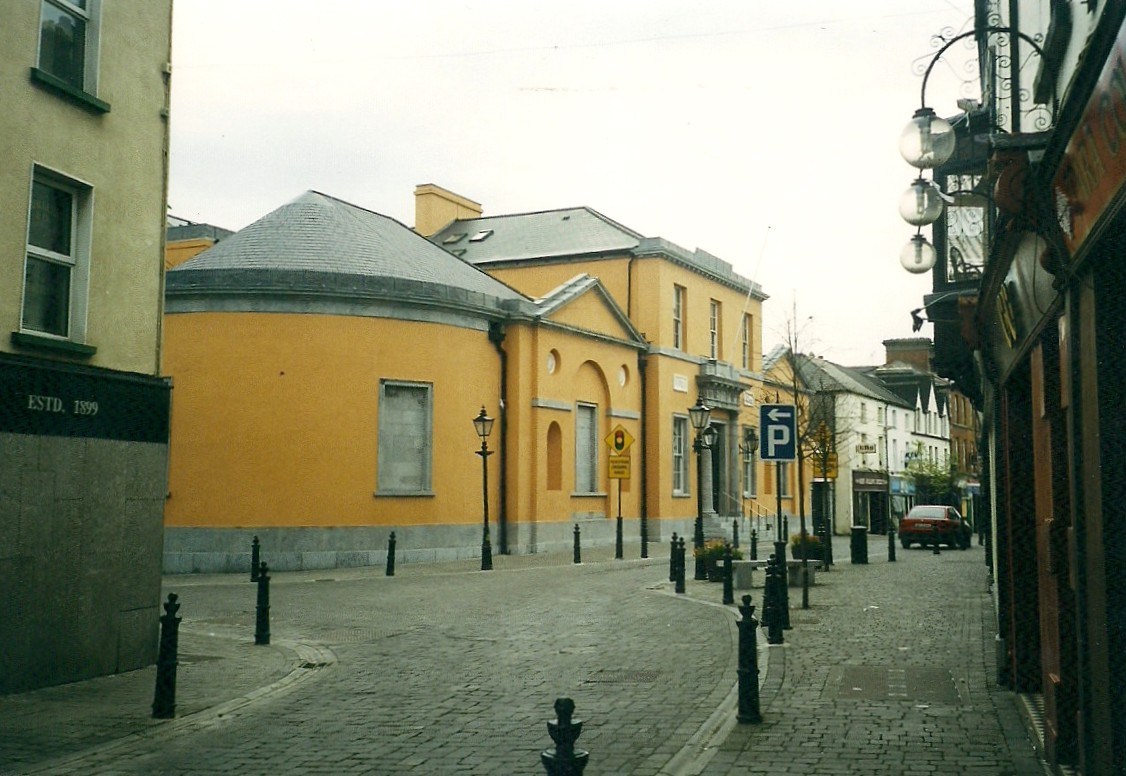Completed in 1805, the courthouse replaced an earlier one destroyed by fire in 1782.1
The curved addition occupies the area where the gallows once stood.
It is believed that the last person to be publicly executed here2 was the Tipperary highwayman 'Captain' Jeremiah Grant who was launched into eternity on
13th August 1816. In the days before his death, he apparently dictated his story to a sympathetic gaoler and this was later published as
The Life and Adventures of Jeremiah Grant. Contemporary newspaper accounts of his exploits make for fascinating, frequently hilarous reading.
On one occasion, he broke into a house, and while his twelve accomplices were 'packing up all the things they conceived worth being carried off',
the bould Captain 'amused himself at the pianoforte whilst tea was preparing'.
And The Freeman's Journal of July 27, 1816, informs us that, for two years, he ran a public house in Wexford where he was known
to all and sundry as George Clooney. According to local tradition, Grant lies buried in the old St Peter's Churchyard in Railway Street.
In 1990, he was commemorated - but certainly not glorified - in Coins, a brilliant poem by Portlaoise poet, Pat Boran.
As listed in Griffth's Valuation, the occupier of the courthouse premises was the Grand Jury of the Queen's County. For centuries, the Grand Jury system was a form of local
government which presided over the construction and maintenance of roads and bridges and such public institutions as infirmaries, courthouses, dispensaries, gaols etc.
The members were generally landowners and wealthy merchants chosen by the High Sheriff of the county, and it wasn't until 1793 that Catholics - the vast majority of the
population - were allowed serve on Grand Juries. The system was frequently accused of corruption and was eventually replaced
by democratically-elected County Councils.
In 1857, at the request of the Town Commission, the British Secretary of War presented the people of Maryborough
with a 'trophy' from the Crimean War which had ended the previous year.
According to the Leinster Express of the time, it was planned to erect a portico at the courthouse 'on the top of which the Russian cannon is to be planted'.
As far as I'm aware, this never happened, but if anyone knows otherwise, I'd love to hear from you.
The first meeting of Queen's County County Council was held in the Courthouse - in the Grand Jury Room overlooking the Main Street - on April 22nd, 1899 and,
until the purpose-built County Hall opened in 1982, part of the building housed local government offices. The inaugural meeting of the new County Council
was described by one of the local papers as 'a very respected and model business-like gathering',
but the Courthouse also hosted what were probably less decorous events; On St Stephen's Night 1928, for instance, you could have supported Maryborough
United Sports Clubs by shaking a leg to the Golden Serenaders Dance Band. Twelve shillings and sixpence for Ladies; fifteen shillings for Gents, and
25 shillings for Doubles! And if that - forgive the anachronism - wasn't your scene, you could have flaunted your cúpla focal at
the Conradh na Gaeilge meetings which were also held here.
In 1901, the 'keeper' of the Courthouse was 83-year-old William Sythes, a retired turnkey who, we learn from
Eddie Boylan, "had a smeg"! He lived here with his daughters Katie Anne, also described as 'Keeper', and Emily, a governess.
Subsequent caretakers included Joe Conway and Jimmy Meehan, the latter a native of Ballyroan who held the position for nearly forty years.
Like his father before him, Jimmy played in the village's famous Brass Band, and many Portlaoise people still recall how his trumpet fanfares and salutes
enhanced the atmosphere of ceremonies in the long-demolished St Peter and Paul's Church. Apropos the latter, perhaps there were
sound architectural or health and safety reasons for its abandonment and eventual demolition but, even today, it's surprising how so many townspeople still
regard its destruction as an act of clerical vandalism.
1
The original courthouse is clearly marked on a 1766 manuscript map which may be inspected by appointment in the Local History section of the library in County Hall.
It makes for fascinating viewing; the entire Coote Street area of the town today is, for instance, completely blank except for a road
running through The Green (details of which appeared in Part One of this project). Also of note is the spelling of the town: Maryborrow.
2
But certainly not the last to be publicly executed in the town. In April 1850, for instance, Catherine Moore, convicted of murdering her husband,
was hanged outside the gaol on the Dublin Road in front of a crowd of nearly a thousand.



HOMEPAGE